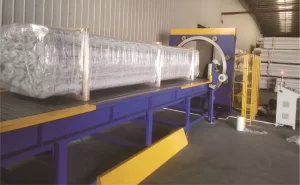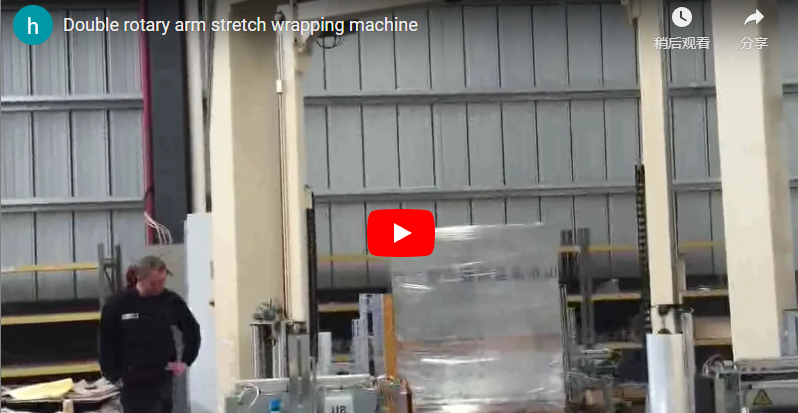Optimizing Coil Spring Logistics: A Deep Dive into Automated Spring Wrapping Machines
1. The Unique Challenge of Packaging Coil Springs
Coil springs, essential components in numerous industries from automotive to manufacturing, present unique packaging challenges. Their inherent shape, potential stored energy, susceptibility to tangling, and often considerable weight make manual packaging time-consuming, potentially unsafe, and prone to inconsistencies. Ensuring these components arrive at their destination undamaged requires a robust and reliable packaging solution. Traditional methods like manual wrapping or boxing often fall short in terms of efficiency, protection, and cost-effectiveness, especially in high-volume operations.
2. Introducing Automated Spring Wrapping Technology
Automated spring packing machines, specifically horizontal orbital wrappers, offer a specialized solution designed to address these challenges. These machines streamline the packaging process by automatically wrapping individual or bundled coil springs securely with materials like stretch film. This automation not only boosts throughput but also significantly enhances the protection and stability of the springs during handling, storage, and transit.
3. Operational Breakdown: How the Machine Works
While designs vary, a typical automatic spring wrapping machine operates through a sequenced process:
- Infeed: Coil springs are placed onto an automated conveyor system, either manually or via integrated upstream processes. Sensors detect the presence of the product.
- Positioning (Optional): Some advanced systems may include mechanisms to automatically center or position the spring optimally for wrapping, ensuring consistent coverage.
- Wrapping Cycle: The conveyor moves the spring into the wrapping zone. A rotating ring, carrying a roll of stretch film (or other packaging material), orbits around the spring GÇô passing through its center GÇô applying overlapping layers of film. The tension and overlap are precisely controlled by the machine's settings.
- Film Cutting and Clamping: Once the predetermined wrap cycle is complete, an automated mechanism clamps the film, cuts it cleanly, and secures the tail end to the package.
- Outfeed: The securely wrapped spring is conveyed out of the machine, ready for palletizing or the next handling stage.
The entire process is typically managed by a Programmable Logic Controller (PLC), allowing for easy adjustment of parameters like wrapping speed, film tension, and overlap percentage.

4. Key Technical Specifications to Consider
When evaluating automated spring wrapping machines, several technical parameters are crucial:
- Product Dimensions:
- Maximum/Minimum Spring Outer Diameter (OD)
- Maximum/Minimum Spring Inner Diameter (ID) (Must be large enough for the wrapping ring to pass through)
- Maximum/Minimum Spring Height/Length
- Machine Performance:
- Ring Rotation Speed (RPM)
- Conveyor Speed (m/min)
- Wrapping Efficiency (Packages per hour)
- Packaging Material:
- Film Roll Width (mm)
- Film Roll Outer Diameter (OD - mm)
- Film Roll Inner Diameter (ID - mm)
- Film Thickness (microns)
- Pre-stretch Ratio Capability (%)
- Utilities:
- Power Supply (V/Hz/Ph)
- Compressed Air Requirements (if applicable) (Pressure/Consumption)
5. The Role of Stretch Film in Spring Protection
Stretch film is the most common wrapping material used in these machines due to its excellent properties:
- Containment Force: Properly applied stretch film provides significant force to hold coils together, preventing unwinding or tangling.
- Puncture Resistance: High-quality film resists punctures from sharp spring ends.
- Load Stabilization: Unitizes bundles of springs or secures single large springs, making them easier and safer to handle.
- Protection: Creates a barrier against dust, moisture, and superficial scratches during transit.
- Clarity: Allows for visual inspection of the product without unwrapping.
Modern machines often feature powered pre-stretch systems, which stretch the film before application. This maximizes film yield (reducing cost) and provides stronger, more consistent load containment compared to non-pre-stretch methods.
6. Operational and Business Benefits
Integrating an automatic spring wrapping machine yields substantial advantages:
- Enhanced Product Protection: Consistent, tight wrapping significantly reduces the risk of damage from environmental factors (dirt, moisture) and physical handling (scratches, abrasion, unwinding). This lowers return rates and improves customer satisfaction.
- Improved Load Stability & Handling: Securely wrapped springs or spring bundles are much more stable, facilitating safer and more efficient loading, unloading, and internal logistics, often using forklifts.
- Increased Packaging Throughput: Automation dramatically speeds up the packaging process compared to manual wrapping, directly increasing overall operational efficiency and freeing up labor.
- Reduced Labor Costs & Improved Safety: Automating this repetitive task reduces the need for manual labor, lowering associated costs. It also mitigates risks of repetitive strain injuries and cuts associated with manual wrapping.
- Packaging Consistency & Quality: Automated systems apply film with consistent tension and overlap every time, ensuring predictable package quality and performance, unlike manual methods which can vary significantly.
7. Practical Experience & Operational Tips
- Film Selection: Match the film gauge (thickness) and properties (puncture resistance, pre-stretch level) to the specific type and weight of the springs being packaged. Heavier or sharper springs require more robust film.
- Tension Settings: Proper film tension is critical. Too loose, and the wrap won't provide stability. Too tight, and it might damage delicate springs or waste film. Experiment to find the optimal setting via the PLC.
- Maintenance: Regular maintenance is key for longevity and performance. Key areas include cleaning rollers, checking film cutter sharpness, inspecting drive belts/chains, and ensuring sensor functionality.
- Integration: Consider how the machine integrates with existing production lines. Input and output conveyor heights and speeds should align for smooth workflow.
- Operator Training: Ensure operators are properly trained on machine operation, safety procedures, film loading, and basic troubleshooting.

8. Conclusion: A Smart Investment in Efficiency and Quality
For manufacturers and distributors dealing with coil springs, investing in an automatic spring packing machine is a strategic move towards greater efficiency, improved product protection, and enhanced workplace safety. These machines offer a reliable, consistent, and high-speed solution to the unique challenges of spring packaging, ultimately contributing to lower operational costs and a more streamlined supply chain. By carefully considering the technical specifications and operational requirements, businesses can select a system that provides significant returns for years to come.






